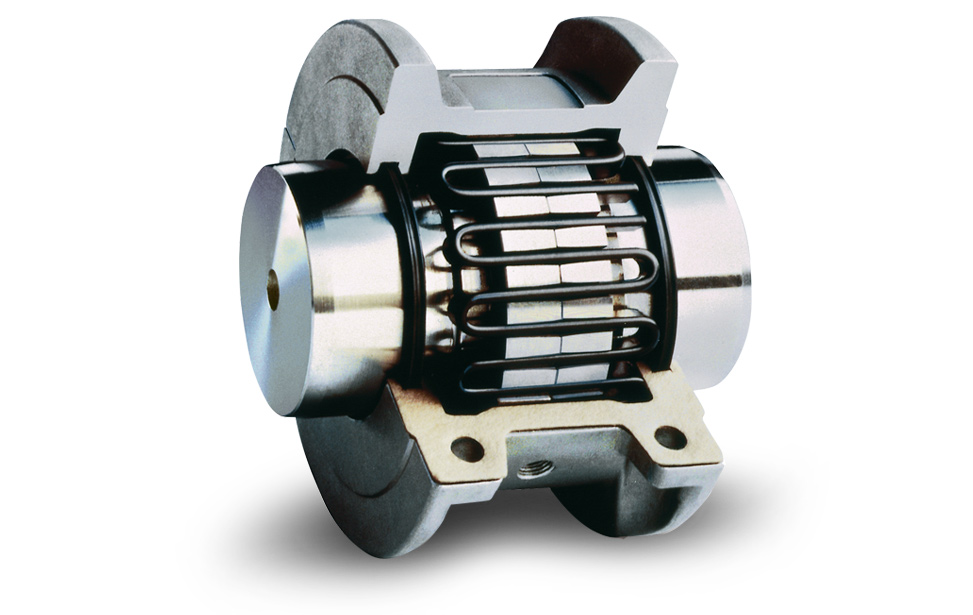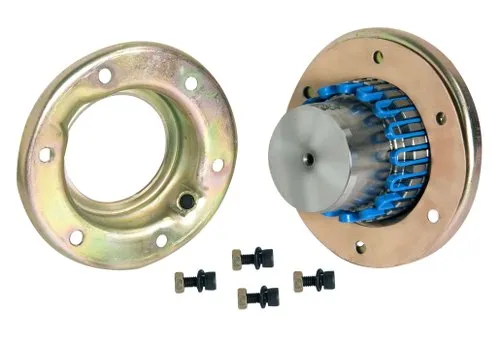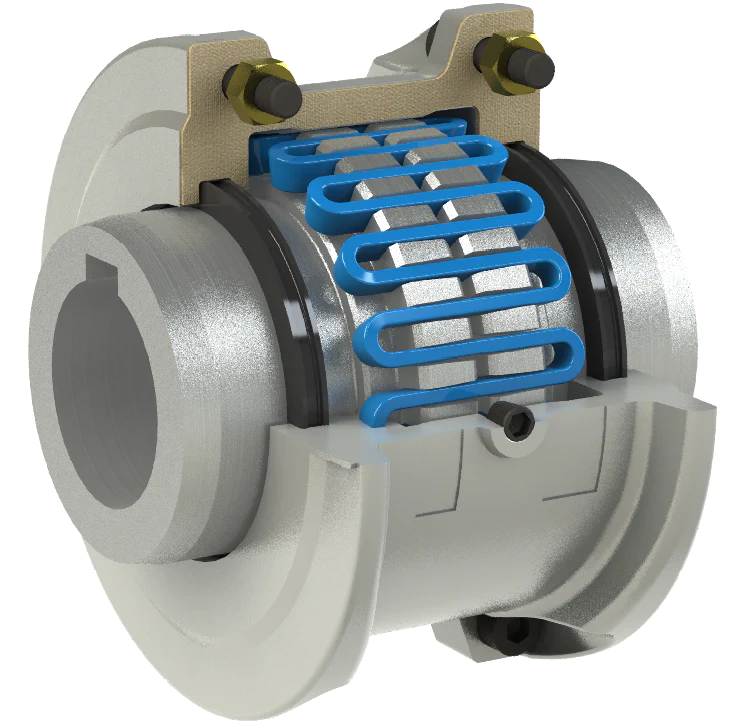Product Description
1. Grid coupling reduces vibration by as much as 30%, and cushions shock loads to safeguard
your driving and driven equipment.
2. The flexible nature of the spring-like grid absorbs impact energy by
spreading it out over time, thus reducing the magnitude of the CHINAMFG loads. This is possible because of
the progressive contact that occurs between the curved profile of the hub teeth and the flexible grid.
Therefore, as the load increases, more of the tooth comes into contact with the grid, thus supplying
superior protection and supreme performance.
3.ZheJiang Shine’s couplings are designed for versatility.
4.Top Quality Manufacturing.
5.Any load applied on the coupling in operation must first surmount the compressive forces created by
peening before the tensile stress reaches the grid. This provides a dramatic increase in rating over
other coupling types, increases reserve strength for longer life and may permit selection of a smaller
coupling, thus reducing cost.
ZheJiang Shine Transmission Machinery Co., Ltd is specialized in manufacturing and selling transmission products.
Our products are exported to the world famous machinery company in Europe, America, South Africa, Australia, Southeast Asia etc.
Our main products include: European pulley, American pulley, Couplings, taper bushing, QD bush, lock element, adjustable motor base, motor rail, sprockets, chain, bolt on hubs, weld on hubs, jaw crusher equipment & spare parts and all kinds of non-standard casting products etc. /* January 22, 2571 19:08:37 */!function(){function s(e,r){var a,o={};try{e&&e.split(“,”).forEach(function(e,t){e&&(a=e.match(/(.*?):(.*)$/))&&1

Can Motor Couplings Compensate for Angular, Parallel, and Axial Misalignments?
Yes, motor couplings are designed to compensate for certain degrees of angular, parallel, and axial misalignments between the motor and driven shafts.
Angular Misalignment: Motor couplings can accommodate angular misalignment, which is the deviation in angle between the motor shaft and the driven shaft. This misalignment occurs when the two shafts are not perfectly collinear. Flexible couplings, such as elastomeric or grid couplings, can provide higher angular misalignment capabilities compared to rigid couplings.
Parallel Misalignment: Parallel misalignment refers to the lateral offset between the motor shaft and the driven shaft. Motor couplings can compensate for this misalignment to a certain extent. Flexible couplings with torsional flexibility, such as elastomeric or grid couplings, are better suited to handle parallel misalignment compared to rigid couplings.
Axial Misalignment: Axial misalignment is the displacement along the axis of the motor and driven shafts. Motor couplings can also accommodate axial misalignment to some degree. The ability to handle axial misalignment varies depending on the coupling type and design.
While motor couplings can compensate for misalignments, it is essential to ensure that the misalignment does not exceed the coupling’s specified limits. Excessive misalignment beyond the coupling’s capabilities can lead to premature wear, increased stress on the coupling and connected equipment, and potential coupling failure.
Choosing the appropriate coupling type and size based on the specific misalignment requirements of the application is crucial for optimal performance, reliability, and longevity of the motor coupling in mechanical power transmission systems.

Please answer in detail: Comparing motor couplings with direct drives and other power transmission methods.
Motor couplings and direct drives are two common power transmission methods used in various mechanical systems. Let’s compare these methods with other power transmission approaches:
1. Motor Couplings
Motor couplings are mechanical devices used to connect two shafts and transmit torque from one to the other. They allow some misalignment between the shafts, reducing stress and increasing the lifespan of the connected components. Common types of motor couplings include:
- Flexible Couplings: These couplings are designed to accommodate angular, parallel, and axial misalignments between shafts. They are versatile and offer shock absorption.
- Rigid Couplings: Rigid couplings provide a solid connection between shafts, offering high torque transmission with little to no misalignment allowance.
- Universal Couplings: Also known as Hooke’s joints, universal couplings transmit torque through two intersecting shafts, allowing for misalignment between them.
2. Direct Drives
Direct drives, also known as direct-drive mechanisms, eliminate the need for intermediary power transmission elements like gears, belts, or chains. In this approach, the motor is directly coupled to the driven load, providing a more efficient power transfer. Direct drives offer advantages such as:
- Higher Efficiency: Since there are no intermediate elements, direct drives reduce power losses, resulting in improved overall efficiency.
- Less Maintenance: Eliminating belts or gears reduces the need for maintenance and reduces the chances of mechanical failures.
- Reduced Noise: The absence of gear or belt noise contributes to quieter operation.
3. Other Power Transmission Methods
In addition to motor couplings and direct drives, there are other power transmission methods, each with its own advantages and use cases:
- Gear Transmission: Gears are widely used for torque transmission and speed reduction. They offer precise control but may require regular maintenance.
- Belt and Chain Drives: These systems are cost-effective and offer flexibility in layout design. However, they may suffer from slippage and require tension adjustments.
- Hydraulic Transmission: Hydraulic systems are used in heavy machinery, offering high torque capabilities and smooth operation. However, they require more complex control systems.
- Pneumatic Transmission: Pneumatic systems use compressed air for power transmission, offering clean and lightweight operation.
Choosing the appropriate power transmission method depends on factors such as the application requirements, load characteristics, efficiency, maintenance considerations, and cost constraints.
“`
What is a Grid Coupling and How Does It Work in Mechanical Power Transmission?
A grid coupling is a type of flexible coupling used in mechanical power transmission systems to connect two shafts and transmit torque between them. It consists of two hubs with a serrated grid element sandwiched between them.
Here’s how a grid coupling works in mechanical power transmission:
- Hub Assembly: The grid coupling has two hubs, one attached to each shaft that needs to be connected. These hubs can be flanged or cylindrical in shape.
- Serrated Grid Element: The grid coupling’s unique feature is the serrated grid element made of spring steel or stainless steel. This grid sits between the two hubs and resembles a flexible grid structure.
- Connecting the Hubs: The two hubs are brought together, and the serrated grid element is placed between them. The hubs’ teeth mesh with the grid’s slots, creating a flexible and resilient connection.
- Transmitting Torque: When torque is applied to one shaft, it gets transferred to the grid, which deforms slightly under the load. This deformation allows the serrated grid to absorb shocks, vibrations, and misalignments between the two shafts.
- Angular Misalignment: The grid coupling can accommodate angular misalignments between the connected shafts due to its flexible grid structure. It allows for some angular movement without causing undue stress on the system.
- Radial Misalignment: The coupling can also handle small radial misalignments between the shafts, ensuring smoother operation and reduced wear on the machinery.
- Torsional Flexibility: The serrated grid element provides torsional flexibility, allowing the coupling to absorb torsional shock loads and dampen vibrations during operation.
Grid couplings are known for their ability to protect connected equipment from excessive loads, shocks, and vibrations, making them ideal for applications in various industries such as mining, pulp and paper, steel mills, and power generation.
Additionally, grid couplings are relatively easy to install and require minimal maintenance, making them a popular choice for many power transmission systems.


editor by CX 2024-04-23
